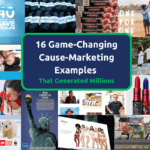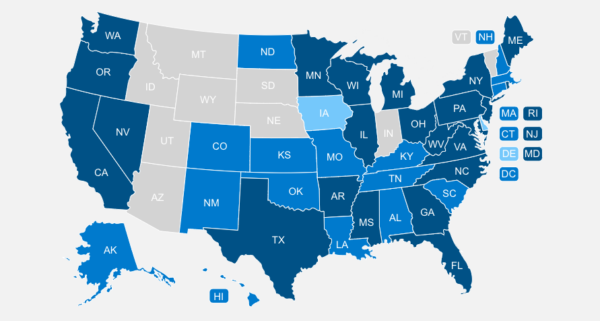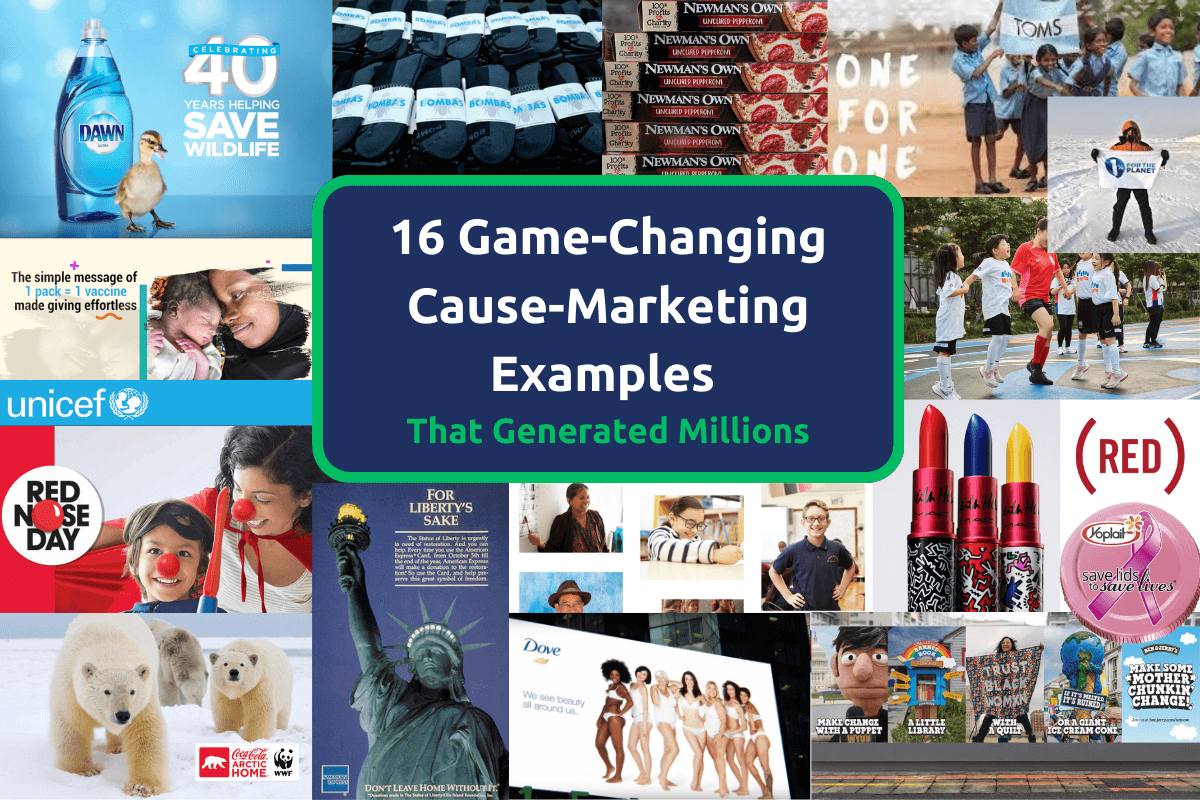
The Top 101 Nonprofit Resources and Tools for Success
January 27, 2025
Cause-Related Marketing: 16 Game-Changing Examples That Generated Millions in Revenue
January 28, 2025The Ultimate Guide to Cause Marketing: How Brands Are Driving $2B+ in Social Impact (2025 Playbook)

Cause marketing has grown from a $1.11 billion industry in 2005 to a game-changer that generated $1.85 billion by 2014. This evolution has changed how brands connect with conscious consumers. Recent studies show that 89% of Americans aged 13 to 25 would switch to a brand associated with a good cause. The numbers speak volumes as 72% of consumers look for companies that share their values.
The effects of cause-related marketing go beyond consumer preference and create measurable business results. American Express showed this brilliantly in 1983. Their campaign supporting the Statue of Liberty restoration led to a 17% increase in new users and 28% growth in card usage. The campaign raised $1.7 million for the cause. Today's market shows even more promise - 42% of Millennials and 70% of Generation Z actively seek socially responsible companies. This piece examines how brands can create and run cause marketing campaigns that appeal to today's purpose-driven consumers.
This piece breaks down everything in successful cause marketing. Readers will find proven strategies and practical steps to create meaningful social impact that propels business development.
What is Cause Marketing: Understanding the $2B+ Impact
Cause marketing started in 1973 with 7-Eleven's partnership with the National Wildlife Federation. The company donated money from cup sales to protect Bald Eagle habitats [1]. A few years later, Marriott Corporation and March of Dimes launched a campaign that raised $2.4 million and brought great publicity to both organizations [1].
Definition and development of cause-related marketing
Cause marketing creates mutually beneficial alliances between for-profit businesses and nonprofit organizations. These partnerships work through promotional campaigns that benefit both sides [1]. American Express made the concept mainstream in 1983 during their Statue of Liberty restoration campaign [1]. The idea has grown beyond simple donations to include marketing activities that affect social and environmental change.
Key statistics and market size
The cause marketing industry has seen remarkable growth from $1.11 billion in 2005 to $1.85 billion by 2014 [1]. Research shows that 89% of consumers would switch brands to support companies that back good causes [1]. Corporate giving through cause marketing reached $21 billion in 2022, a 13.4% increase from the previous year [2].
Types of cause marketing campaigns
Companies now use different approaches to involve consumers and create change:
-
Transactional Campaigns: Companies donate based on consumer purchases or actions [1]
-
Message-Focused Campaigns: Businesses use their resources to share cause-focused messages that change behavior [1]
-
Point of Sale Campaigns: Customers can donate during checkout [1]
-
Buy One Give One: Companies donate products that match customer purchases [1]
-
Digital Engagement: Social-first experiences raise funds and awareness [1]
Studies show these campaigns work well - 76% of consumers trust purpose-driven brands more [2]. Businesses using cause marketing strategies have seen up to 36% increase in customer lifetime value and 51% improvement in retention rates [2].
Designing Successful Cause Marketing Campaigns
Creating cause marketing campaigns that work needs careful planning and smart execution. A successful campaign must line up with brand values and what consumers expect, as 86% of Americans say they want companies to do more than just make a profit [3].
Campaign types and formats
Successful cause marketing initiatives usually fit into these distinct categories:
-
Transactional Campaigns: Where companies donate a specific amount per purchase
-
Message-Focused Campaigns: Raising awareness through educational content
-
Point-of-Sale Programs: Collecting donations at checkout, with 69% of consumers taking part in such programs [4]
-
Digital Engagement: Using social media and online platforms
-
Employee Engagement: Getting staff involved with charitable activities
Best practices and common pitfalls
Brands must prioritize transparency and authenticity to create influential campaigns. Clear communication about donation amounts and beneficiaries becomes essential, as studies show that 75% of Americans donate annually through channels of all types [4].
Common pitfalls to avoid include:
-
Picking causes that don't match brand values
-
Setting unclear donation parameters
-
Not being transparent about fund distribution
-
Making participation too complex
Case studies of successful campaigns
Several campaigns achieved remarkable results by doing this. Yoplait's "Save Lids to Save Lives" campaign raised over $50 million in donations [5]. Their profits went up by 2.70% during the campaign period [4].
Ben & Jerry's "Justice ReMix'd" initiative shows another success story that combined product sales with criminal justice reform advocacy [6]. BoxLunch's collaboration with Feeding America has also provided over 150 million meals to communities in need [6].
Building Authentic Brand-Cause Partnerships
The life-blood of successful cause marketing initiatives lies in choosing the right nonprofit partner. Research shows that brands who stay transparent about their partnerships gain 85% more consumer loyalty [7].
Partner selection criteria
A brand needs to evaluate potential partners thoroughly before building authentic partnerships. The assessment should focus on:
-
How well the mission fits company values
-
The organization's credibility and reputation
-
Their geographic and demographic reach
-
Strong financial health and transparency
-
Success stories from previous collaborations
Negotiating win-win partnerships
Successful partnerships need clear legal frameworks and mutual understanding. Studies reveal that 70% of consumers expect brands to take positions on social issues [2]. A detailed partnership agreement should spell out specific objectives, financial commitments, and activation strategies [8].
Both parties need to set clear expectations about these key areas before signing any agreement:
-
How long the campaign runs and what rights it includes
-
Rules for using logos and brand assets
-
When and how payments happen
Managing long-term relationships
Strong partnerships need constant communication and dedication. Research shows that 61% of consumers notice genuine social responsibility when companies deepen their commitment to causes over time [7].
The collaborative efforts grow stronger through regular check-ins and open updates. Teams should track their progress using predetermined KPIs and share wins with stakeholders [2]. They should also stay flexible enough to adjust strategies based on performance data and market changes.
Authenticity, clear communication, and mutual respect help partnerships thrive. Brands and nonprofits can build lasting relationships that create meaningful social change and business value by setting clear goals and staying involved consistently [9].
Digital-First Cause Marketing Tactics
Digital platforms have changed how brands run their cause marketing campaigns. Social media leads the way to involve and affect audiences. Research shows that digital channel campaigns achieve 87% higher engagement rates [10] than traditional methods.
Social media and influencer partnerships
Social media platforms are vital to cause marketing success. Studies reveal that 77% of participants think sharing positive opinions about socially responsible companies on social platforms is "very important" [11]. Partnerships with influencers magnify this effect. Data shows that campaigns with influencer content raise 143% more funds than those without [12].
Content strategy and storytelling
Digital storytelling remains at the heart of successful cause marketing. Brands using emotional narratives experience 22 times higher message retention [13] from their audience. Studies show 57% of people watching nonprofit videos make donations afterward [13].
Digital content succeeds when it:
-
Gets 79% higher engagement with personal impact stories [14]
-
Builds 76% more trust when CEOs talk about causes through digital channels [10]
-
Reaches 40% of customers who are "purpose-driven" in their digital interactions [15]
Marketing automation and technology integration
Marketing automation has changed how organizations run cause-related campaigns. Automated donation systems have helped 69% of consumers give at point-of-sale in the last 12 months [4]. Organizations that use marketing automation for cause campaigns see 75% higher donor retention rates [16].
Payment integration technology makes giving easier. 40% of donors say they wouldn't have given without digital payment options [4]. Automated email campaigns supporting causes achieve 15% conversion rates. This is a big deal as it means that the industry average of 2% [17] is far behind.
Maximizing Campaign Impact
Data-driven optimization and mutually beneficial alliances form the foundation of successful cause marketing campaigns. Research shows that companies using integrated marketing strategies achieve a 287% higher purchase rate compared to single-channel approaches [18].
Boosting strategies
Campaign success depends on careful attention to key performance indicators. Companies that use customer behavioral insights perform better than their peers by 85% in sales growth and more than 25% in gross margin [18]. This success comes from:
-
Campaign reach and awareness metrics
-
Engagement rates across platforms
-
Conversion tracking and attribution
-
Live data analysis
-
Customer sentiment monitoring
Cross-channel integration
Modern cross-channel integration needs smooth data sharing across all touchpoints. Studies show that new customers need seven to eight touchpoints before conversion [19]. Companies that maintain consistent branding and messaging across channels see 67% higher customer retention rates [19].
Cross-channel campaigns succeed through coordinated execution and live consumer behavior analysis. Companies using integrated data management software report 54.7% higher conversion rates [20] when they streamline processes through channel coordination.
Scaling successful programs
Successful cause marketing programs need systematic evaluation and optimization to scale. Companies that use data-driven scaling strategies see a 19% increase in conversion rates and a 23% increase in average order value [20].
Companies should measure specific metrics across channels to maximize results. Research shows that businesses tracking complete analytics achieve 40% higher engagement [21] and 71% better campaign performance [21] compared to those using simple metrics alone.
Continuous optimization based on performance data helps sustainable scaling. Organizations can spot trends and patterns to improve their strategies by analyzing metrics from different channels [18]. This method has helped companies raise up to 143% more funds through optimized campaigns [22].
Future of Cause Marketing
The cause marketing landscape will see major changes by 2025. Recent global events have led 50% of consumers to completely rethink their personal values. This creates new opportunities for brands that know how to respond [23].
Emerging technologies and platforms
Responsible artificial intelligence is pioneering cause marketing progress. Currently, only 3 in 10 nonprofits use this technology [3]. Brands now use predictive analytics and machine learning to connect with socially conscious consumers. These tools have shown up to 78% better campaign results [24].
Digital platforms have created new ways for consumers to support causes. People increasingly use mobile apps and digital payments in cause marketing campaigns. Studies show 61% of consumers would try new brands that back meaningful causes [25].
Consumer choices are shaping cause marketing's future. About 83% of people look for more products and services linked to social causes [25]. Brands are now focusing on:
-
Blockchain technology to track results instantly
-
Cause selection tailored to consumer priorities
-
AR experiences that tell cause stories
-
Donation systems that work with daily activities
By 2025, informed personalization will be crucial to cause marketing success. About 75% of consumers need better updates about corporate social responsibility efforts [26]. Brands ended up needing both tech innovation and genuine human connection. Trust matters - 81% of global consumers would give to charities backed by companies they believe in [23].
Mobile technology has opened new doors for cause marketing participation. Experts predict users will download over 2.5 billion mobile AR apps yearly by 2025. These apps offer exceptional opportunities for immersive cause-related experiences [26].
The cause marketing world of 2025 will focus more on transparency and measurable results. Companies must adapt as 86% of people want more details about social responsibility efforts [26]. This progress shows a move toward purpose-driven commerce. Technology helps create stronger bonds between brands, causes, and conscious consumers.
Conclusion
Cause marketing has grown beyond simple donations into a sophisticated approach that generates billions in social change. Research proves that purpose-driven campaigns create real business results and positive community effects. Companies that build authentic relationships and welcome digital breakthroughs see much higher customer loyalty rates.
More than 80% of consumers now actively look for products connected to social causes. This trend continues to shape the market. Successful brands know they need both tech advances and real human connections to make a difference. Their campaigns tell powerful stories and track results openly. This creates stronger bonds between brands and socially conscious buyers.
Modern cause marketing campaigns can be complex. Smart companies understand this reality. Nationwide commercial co-venture registration rules are hard to follow. You shouldn't spend time figuring out state requirements alone. We have handled thousands of registrations and campaign filings as the sector's longest-standing fundraising compliance service provider. Our team will handle your commercial co-venture registration applications, manage contract submissions, and file financial reports.
Brands can build lasting relationships that help both business and society through clear communication and genuine involvement. Companies that follow this path while staying compliant will lead the next wave of cause marketing breakthroughs. This approach will create even greater social change over the next several years.
References
[1] - https://en.wikipedia.org/wiki/Cause_marketing
[2] - https://www.brandpartnerships.co/blog/the-importance-of-authenticity-in-brand-partnerships
[3] - https://www.linkedin.com/pulse/conscious-marketing-2025-trends-driving-nonprofits-forward-madill-bfykc
[4] - https://extension.psu.edu/cause-marketing-program-strategies
[5] - https://www.psh.com/legal-pitfalls-to-avoid-in-social-cause-marketing-campaigns/
[6] - https://doublethedonation.com/cause-marketing-examples/
[7] - https://donorbox.org/nonprofit-blog/cause-marketing
[8] - https://www.sponsorunited.com/sponsorship-101/negotiating-sponsorship-agreements
[9] - https://www.epromos.com/education/promo-marketing/guide-to-authentic-cause-marketing/?srsltid=AfmBOoqej1CQNmA-KOVrdhq9UAb65LS1-7ibjdK7ZIC-9UdjIkZ5nxU4
[10] - https://www.phoenix.edu/blog/what-is-cause-marketing.html
[11] - https://markitors.com/5-examples-of-cause-marketing-in-social-media/
[12] - https://blog.carusele.com/influencer-marketing-impact-cause-marketing
[13] - https://recharity.ca/nonprofit-storytelling-techniques-4-inspiring-examples/
[14] - https://www.workamajig.com/marketing-guide/cause-marketing-for-agencies
[15] - https://www.forbes.com/councils/forbesagencycouncil/2022/10/11/cause-marketing-with-social-media-influencers-4-reasons-it-works/
[16] - https://www.redeye.com/resources/the-top-10-marketing-automation-campaign-ideas-for-nonprofits-and-charities/
[17] - https://moosend.com/blog/cause-related-marketing/
[18] - https://www.forbes.com/councils/forbesagencycouncil/2024/03/26/how-marketing-integration-boosts-cross-channel-success/
[19] - https://www.salesforce.com/marketing/personalization/cross-channel-marketing-guide/
[20] - https://getchange.io/blog/introduction-to-ecommerce-master-class-increase-sales-with-cause-marketing
[21] - https://www.forbes.com/councils/forbesagencycouncil/2023/07/10/7-ways-to-use-analytics-to-boost-performance-marketing-campaigns/
[22] - https://fastercapital.com/content/Cause-marketing-metrics--Measuring-Impact--Key-Metrics-for-Cause-Marketing-Campaigns.html
[23] - https://www.accenture.com/us-en/insights/strategy/reimagined-consumer-expectations
[24] - https://www.marketingdive.com/news/marketing-predictions-for-2025/736381/
[25] - https://www.3blmedia.com/news/even-cause-marketing-grows-83-percent-consumers-still-want-see-more
[26] - https://www.houstonforesight.org/wp-content/uploads/2024/05/Daken-Future-of-Cause-Marketing-Executive-2012.pdf




